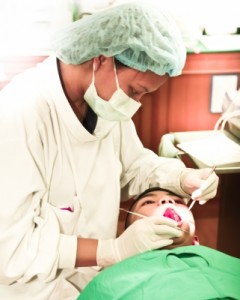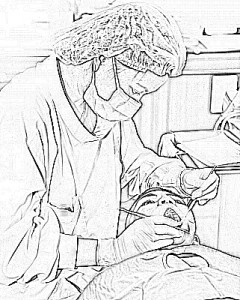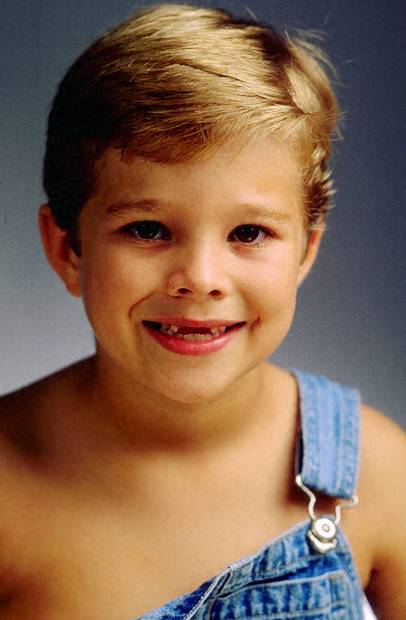1. Why do people go to the dentist?
People go to the dentist for a dental checkup, and to have their teeth cleaned.
2. What is the boy in the picture doing?
He is getting a checkup and having his teeth cleaned by the dentist.
3. Why do people often avoid going to the dentist?
People often avoid going to the dentist because they are afraid it will hurt, or because they don’t like the sound of the dentist’s drill.
4. How often should you get a checkup?
You should get a dental checkup once every six months.
5. What does the dentist or hygienist look for during a checkup?
The dentist or dental hygienist looks for cavities during a checkup. He also looks to see how healthy your gums are. When the dentist cleans your teeth, he removes tartar (dental calculus) from your teeth.
6. How can the dentist find very small cavities that are hard to see during a checkup?
Sometimes there are cavities that are too small for the dentist to see in his visual inspection, so he can take an x-ray to see these tiny cavities.
7. What can you do to help prevent cavities?
Brushing after every meal, and flossing daily are important in helping to prevent cavities, because they remove plaque. If plaque remains on your teeth, the bacteria that live there produce acids which create the holes, or cavities, in your teeth. Other things that you can do to help prevent cavities are avoiding sugary foods and drinks, and using fluoride toothpaste and/or fluoride mouth rinse.
8. What happens if you have a cavity?
If you have a cavity, the dentist has to put a filling in it so it doesn’t get bigger.
9. When the dentist fills a cavity, what does he do first?
First, the dentist must drill the tooth to get rid of all the decay before he can put a filling in. Usually, he will give you some anesthetic (like a shot [or injection] of Novocain) to numb the area so you don’t feel anything.
10. What are fillings made of?
Fillings used to be made of amalgam, but these are not used so much anymore because they have trace amounts of mercury, and they don’t look very nice in the teeth. He can put in a gold filling, but gold is too expensive for most people. So it is most common to use bonding, where the color of the filling is close to the natural color of the tooth.
11. What happens if your tooth has a cavity that’s too big?
If the cavity is too big, the dentist might have to take off the part that’s above the gum line, and replace it with a crown. If the root is bad as well, the whole tooth might have to be pulled (extracted).
12. What can you do if you lose a tooth?
If you lose a tooth, you can replace it with an implant.
13. What can you do if you lose several teeth?
If you lose several teeth, you can replace all of them with implants. You can also use false teeth, or dentures, to replace the missing teeth.
14. What are some other things that the dentist can find wrong with your teeth or mouth?
The dentist can also tell if you have an impacted tooth, chipped teeth, or crooked teeth. The dentist can also tell if you have gingivitis, periodontal disease, or bad breath (halitosis).
15. Whom can you see if you have crooked teeth?
If you have crooked teeth and want to have them straightened, you can visit an orthodontist.
16. How can the orthodontist help you get straight teeth?
The orthodontist can help you get straight teeth by fitting you with braces.
17. How does a baby get teeth?
Starting around 5 months of age, a baby’s teeth will start to cut through the gum and grow in. We call this process teething.
18. What happens eventually to baby teeth?
The baby teeth become lose because the adult teeth underneath start to grow in, pushing the baby teeth out.
19. What are some things that different cultures do with baby teeth that have fallen out?
Some cultures throw the baby teeth over the roof of the house, some cultures bury the teeth in the ground, and some cultures put the baby tooth under the pillow, where it is taken by a fairy or a mouse.
20. What are the last adult teeth to come in?
The last adult teeth to come in are the wisdom teeth. The wisdom teeth are usually removed since they often don’t come in all the way, and become impacted.
Paragraph: A Visit to the Dentist
When you go to the dentist, he will have you sit in the dentist’s chair for your examination. He will put something like a bib around your neck, and tell you to open wide while he pokes around in your mouth, visually inspecting your teeth and gums for any problems. Wearing rubber gloves, the dentist will use his dental pick to clean your teeth, removing tartar from in between the teeth, under the gum line, and other hard-to-reach places. After that, he will polish your teeth with some special paste and a type of hand-held buffer. If he takes x-rays of your teeth, he will put a lead apron over your torso to prevent unnecessary exposure to radiation. Then he will insert the x-ray cards in your mouth and turn on the machine to take an x-ray.
If you need to have a cavity filled, the dentist will first give you some anesthetic – usually a shot of Novocain. This is to make your mouth numb in the area where he has to drill, so it won’t hurt. The dentist must drill to remove the decayed portion of the tooth before he fills it. He may use mercury (silver) amalgam, which is relatively inexpensive, or he may use bonding to fill the tooth with natural-colored resin fillings. Some people may wish to use gold for a filling instead, but of course this is more costly.
After he has finished working on your teeth, the dentist may tell you to rinse and spit. Part of the reason for this is to eliminate any debris, grit, or saliva that might remain in your mouth after the procedure, but the other reason is to get rid of any unpleasant taste.
As nice a fellow as your dentist might be, you probably don’t want to visit him any more than you have to. So you want to be sure that you floss at least once a day, and brush after every meal – these are small and easy but important steps that you can take to make sure that your teeth will last a lifetime, and to keep yourself in good dental health.



